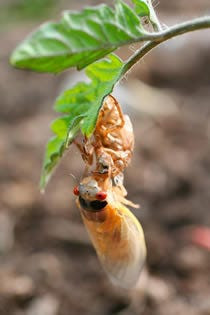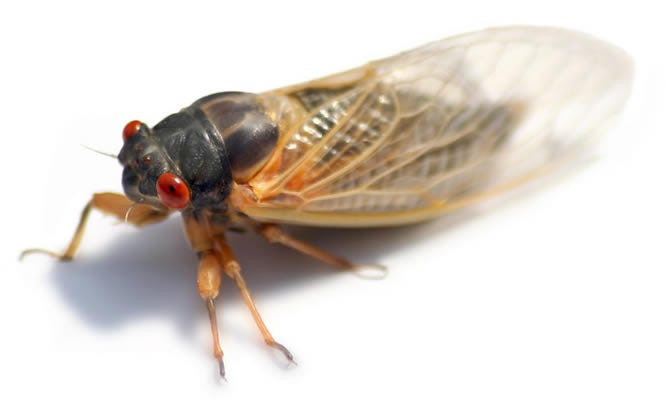Cicadas, those buzzing insects that emerge periodically, often leave people wondering about their behavior. Do Cicadas Fly In Swarms? Yes, cicadas, particularly periodical cicadas, are well-known for emerging in massive swarms, creating a spectacle that can be both fascinating and overwhelming. At flyermedia.net, we dive deep into the world of aviation and related topics, and understanding the natural world around us, including insect behavior like cicada swarming, can provide a broader perspective. Understanding cicada behavior is essential for those interested in entomology, agriculture, and even aviation, as large swarms can sometimes pose a hazard to low-flying aircraft. Let’s explore the fascinating phenomenon of cicada swarms, their impact, and what makes them so unique.
1. What is a Cicada Swarm?
A cicada swarm refers to the simultaneous emergence of a large number of cicadas in a specific area. These swarms are most commonly associated with periodical cicadas, which spend most of their lives underground as nymphs before emerging en masse as adults. This phenomenon is less common with annual cicadas, which emerge in smaller numbers each year.
1.1. Periodical Cicadas: The Swarming Experts
Periodical cicadas are famous for their synchronized emergences, which occur every 13 or 17 years, depending on the brood. These emergences involve millions, even billions, of cicadas appearing across several states. According to research from the University of Connecticut, the synchronized emergence is a survival strategy to overwhelm predators.
1.2. Annual Cicadas: A Less Dramatic Display
Annual cicadas, also known as dog-day cicadas, emerge every summer. They do not swarm in the same way as periodical cicadas, but their constant buzzing can still be quite noticeable. Their numbers are smaller, and their emergence is spread out over several weeks or months.
2. Why Do Cicadas Fly in Swarms?
Cicadas swarm as a survival mechanism. The sheer number of cicadas emerging at once overwhelms predators, ensuring that a significant portion of the population survives to reproduce.
2.1. Predator Satiation
Predator satiation is the primary reason cicadas swarm. By emerging in such large numbers, cicadas provide a feast for birds, reptiles, and other predators. However, the cicada population is so vast that predators can only consume a fraction of them, leaving many to mate and lay eggs. According to a study by the University of Maryland, predator satiation is most effective when cicada density exceeds a certain threshold.
2.2. Mating Opportunities
Swarming also increases the chances of successful mating. The high density of cicadas in a swarm makes it easier for males to attract females and reproduce. The loud buzzing, or singing, of male cicadas is a mating call designed to attract females.
2.3. Genetic Diversity
Mass emergences promote genetic diversity within cicada populations. By mixing genes from different individuals, swarming helps ensure the long-term health and adaptability of the species. Research from the University of Illinois suggests that genetic diversity is crucial for cicadas to adapt to changing environmental conditions.
3. What Does a Cicada Swarm Look Like?
A cicada swarm is a sight to behold. Millions of insects fill the air, covering trees, buildings, and the ground. The sound of their buzzing is deafening, creating an unforgettable sensory experience.
3.1. Visual Spectacle
Visually, a cicada swarm can be overwhelming. Trees appear to be covered in insects, and the ground may be littered with cicada exoskeletons. The sheer number of cicadas in flight can create a buzzing cloud.
3.2. Auditory Experience
The sound of a cicada swarm is equally impressive. Male cicadas produce a loud, buzzing noise by vibrating membranes called tymbals on their abdomen. When millions of cicadas sing in unison, the sound can reach deafening levels, sometimes exceeding 100 decibels.
 Cicada on a leaf
Cicada on a leaf
3.3. Impact on the Environment
Cicada swarms can have a noticeable impact on the environment. While adult cicadas do not cause significant damage, their egg-laying behavior can harm young trees. Additionally, the sheer number of dead cicadas can create a temporary nuisance.
4. Where Do Cicada Swarms Occur?
Cicada swarms primarily occur in North America, particularly in the eastern and midwestern United States. The specific locations vary depending on the brood and the year.
4.1. Regional Variations
Different broods of periodical cicadas emerge in different regions of the United States. For example, Brood X, one of the largest and most widespread broods, emerges in states like Delaware, Georgia, Illinois, Indiana, Kentucky, Maryland, Michigan, North Carolina, New Jersey, New York, Ohio, Pennsylvania, Tennessee, Virginia, and West Virginia.
4.2. Habitat Preferences
Cicadas prefer wooded areas with mature trees, as these provide both food and shelter. They are less common in urban areas with limited tree cover. A study by Ohio State University found that cicada density is highest in forests and parks.
4.3. Impact of Climate Change
Climate change may be affecting cicada emergence patterns. Warmer temperatures can cause cicadas to emerge earlier than expected, disrupting their synchronized life cycle. Research from the University of Michigan suggests that climate change could lead to more frequent and unpredictable cicada emergences.
5. When Do Cicada Swarms Occur?
Cicada swarms occur in the spring and early summer, typically from May to June. The exact timing depends on the species and the weather conditions.
5.1. Temperature Triggers
Cicadas emerge when the soil temperature reaches around 65°F (18°C) at a depth of about 8 inches. This temperature threshold triggers the nymphs to leave their underground burrows and begin their transformation into adults.
5.2. Emergence Timing
The emergence of periodical cicadas is highly synchronized. Within a few days or weeks, millions of cicadas emerge simultaneously. This synchronized emergence is one of the most remarkable aspects of their life cycle.
5.3. Life Cycle Stages
Cicadas have a complex life cycle that includes several stages:
-
Egg: Female cicadas lay their eggs in tree branches.
-
Nymph: After hatching, the nymphs drop to the ground and burrow underground, where they feed on tree roots for years.
-
Emergence: When the soil temperature is right, the nymphs emerge from the ground.
-
Adult: The adult cicadas mate and lay eggs before dying.
 Cicada infestation
Cicada infestation
6. Are Cicada Swarms Harmful?
Cicada swarms are generally not harmful to humans or the environment. However, they can be a nuisance due to their noise and sheer numbers.
6.1. Impact on Plants
While adult cicadas do not feed on plants, female cicadas can damage young trees when they lay their eggs. The egg-laying process involves cutting slits in tree branches, which can weaken or kill young trees. According to the USDA Forest Service, this damage is usually minimal, but it can be significant in orchards and nurseries.
6.2. Nuisance Factors
The primary nuisance associated with cicada swarms is their noise. The loud buzzing of millions of cicadas can be disruptive and annoying. Additionally, the sheer number of dead cicadas can create a foul odor as they decompose.
6.3. Potential Hazards to Aviation
Large cicada swarms can pose a potential hazard to aviation, particularly for small aircraft. The insects can reduce visibility and potentially clog engine intakes. However, there are no documented cases of cicada swarms causing serious aircraft accidents. It’s always important for pilots to be aware of local conditions and potential hazards, as noted by the FAA.
7. How to Prepare for a Cicada Swarm?
If you live in an area where cicada swarms are common, there are several steps you can take to prepare:
7.1. Protect Young Trees
The most important step is to protect young trees from cicada damage. This can be done by covering them with netting or cheesecloth during the emergence period. This prevents female cicadas from laying their eggs in the branches.
7.2. Manage the Noise
There is little you can do to manage the noise of a cicada swarm. Earplugs can help reduce the sound levels, but the buzzing is likely to be noticeable regardless.
7.3. Clean Up Dead Cicadas
After the cicadas die, it is a good idea to clean up their bodies to reduce the odor. This can be done by raking them up and disposing of them in the trash or compost.
8. Interesting Facts About Cicadas
Cicadas are fascinating creatures with many unique characteristics. Here are a few interesting facts:
8.1. Longest Insect Life Cycle
Periodical cicadas have one of the longest insect life cycles, spending 13 or 17 years underground as nymphs. This is one of the most remarkable adaptations in the insect world.
8.2. Unique Mating Calls
Male cicadas produce a variety of mating calls, each unique to their species. These calls are used to attract females and can be quite loud. According to research from the University of Florida, some cicada species can produce calls exceeding 100 decibels.
8.3. Edible Insects
Cicadas are edible and have been consumed by humans for centuries. They are a good source of protein and can be prepared in a variety of ways. According to entomophagy experts, cicadas are best eaten shortly after they emerge from their nymphal skins.
 Cicada
Cicada
9. Cicadas and Aviation: What Pilots Need to Know
While cicada swarms don’t typically cause significant aviation incidents, pilots should be aware of the potential risks and take necessary precautions.
9.1. Visibility Concerns
Dense cicada swarms can reduce visibility, making it difficult for pilots to see other aircraft or terrain. Pilots should exercise caution and consider delaying flights if visibility is significantly impaired.
9.2. Engine Intake Risks
There is a theoretical risk that cicadas could be ingested into aircraft engines, potentially causing engine malfunction. While this is unlikely, pilots should be vigilant and monitor engine performance during cicada emergences.
9.3. Pre-Flight Inspections
Pilots should conduct thorough pre-flight inspections to ensure that no cicadas are obstructing critical components, such as air intakes or control surfaces.
9.4. Reporting Procedures
Pilots who encounter significant cicada swarms should report the information to air traffic control to alert other pilots in the area.
10. Conclusion: The Wonder and the Buzz
Cicada swarms are a natural phenomenon that can be both fascinating and overwhelming. Understanding their behavior, life cycle, and potential impact can help you prepare for and appreciate these unique events. While they may be a nuisance, cicada swarms are generally harmless and provide a valuable ecological service.
10.1. Embrace the Experience
Instead of fearing cicada swarms, try to embrace the experience. They are a reminder of the natural world’s complexity and resilience.
10.2. Learn More
To learn more about cicadas and other insects, visit your local library or contact your county extension office.
10.3. Stay Informed
Stay informed about upcoming cicada emergences by following news reports and scientific research.
FAQ About Cicadas
1. What are cicadas?
Cicadas are insects known for their loud buzzing sounds and periodical emergences. They spend most of their lives underground as nymphs before emerging as adults to mate and lay eggs.
2. How long do cicadas live?
The lifespan of cicadas varies depending on the species. Annual cicadas live for about 2-5 years, while periodical cicadas live for 13 or 17 years.
3. Why do cicadas make so much noise?
Male cicadas make noise to attract females for mating. They produce a loud buzzing sound by vibrating membranes called tymbals on their abdomen.
4. Are cicadas harmful to humans?
Cicadas are not harmful to humans. They do not bite or sting and are not known to transmit diseases.
5. Can cicadas damage trees?
Female cicadas can damage young trees when they lay their eggs. The egg-laying process involves cutting slits in tree branches, which can weaken or kill young trees.
6. What is the difference between annual and periodical cicadas?
Annual cicadas emerge every summer, while periodical cicadas emerge every 13 or 17 years. Periodical cicadas also emerge in much larger numbers than annual cicadas.
7. How can I protect my trees from cicadas?
You can protect young trees by covering them with netting or cheesecloth during the cicada emergence period.
8. Are cicadas edible?
Yes, cicadas are edible and have been consumed by humans for centuries. They are a good source of protein.
9. What should I do if I find a cicada in my house?
If you find a cicada in your house, you can gently catch it and release it outside.
10. How do cicadas benefit the environment?
Cicadas benefit the environment by aerating the soil, providing food for predators, and contributing to nutrient cycling.
At flyermedia.net, we strive to provide you with comprehensive and engaging content on a variety of topics, from aviation to natural phenomena. We hope this article has answered your questions about cicada swarms and provided you with a deeper appreciation for these fascinating insects.
Ready to explore more about the world around us and the skies above? Visit flyermedia.net today to discover a wealth of information on aviation, travel, and more. Whether you’re seeking flight training, aviation news, or career opportunities, flyermedia.net is your go-to resource.
Explore. Discover. Fly with flyermedia.net.